In the ever-escalating evolutionary battle with drug-resistant bacteria, humans may soon have a leg up thanks to adaptive, light-activated nanotherapy.

‘New light-activated therapeutic nanoparticles known as 'quantum dots' have been observed to successfully kill 92% of drug-resistant bacterial cells in a lab-grown culture.’





In findings published in Nature Materials, researchers at the Department of Chemical and Biological Engineering and the BioFrontiers Institute describe new light-activated therapeutic nanoparticles known as 'quantum dots'. The dots, which are about 20,000 times smaller than a human hair and resemble the tiny semiconductors used in consumer electronics, successfully killed 92% of drug-resistant bacterial cells in a lab-grown culture. "By shrinking these semiconductors down to the nanoscale, we're able to create highly specific interactions within the cellular environment that only target the infection," said Prashant Nagpal, an assistant professor in the Department of Chemical and Biological Engineering at CU-Boulder and a senior author of the study.
Previous research has shown that metal nanoparticles - created from gold and silver, among other metals - can be effective at combating antibiotic resistant infections, but can indiscriminately damage surrounding cells as well.
The quantum dots, however, can be tailored to particular infections thanks to their light-activated properties. The dots remain inactive in darkness, but can be activated on command by exposing them to light, allowing researchers to modify the wavelength in order to alter and kill the infected cells.
"While we can always count on these superbugs to adapt and fight the therapy, we can quickly tailor these quantum dots to come up with a new therapy and therefore fight back faster in this evolutionary race," said Nagpal.
Advertisement
Anushree Chatterjee, an assistant professor in the Department of Chemical and Biological Engineering at CU-Boulder and a senior author of the study, said, "Antibiotics are not just a baseline treatment for bacterial infections, but HIV and cancer as well. Failure to develop effective treatments for drug-resistant strains is not an option, and that's what this technology moves closer to solving."
Advertisement











